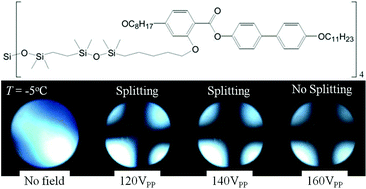Surface alignment, anchoring transitions, optical properties, and topological defects in the thermotropic nematic phase of organo-siloxane tetrapodes
Abstract
We perform optical, surface anchoring, and textural studies of an organo-siloxane “tetrapode” material in the broad temperature range of the nematic phase. The optical, structural, and topological features are compatible with the uniaxial nematic order rather than with the biaxial nematic order, in the entire nematic temperature range −25 °C < T < 46 °C studied. For homeotropic alignment, the material experiences surface anchoring transition, but the director can be realigned into an optically uniaxial texture by applying a sufficiently strong electric field. The topological features of textures in cylindrical capillaries, in spherical droplets and around colloidal inclusions are consistent with the uniaxial character of the long-range nematic order. In particular, we observe isolated surface point defects – boojums and bulk point defects – hedgehogs that can exist only in the uniaxial nematic liquid crystal.


 Please wait while we load your content...
Please wait while we load your content...